|
|

|
|
Author
|
Topic: Cassini to take photo of Earth: "Wave at Saturn"
|
Robert Pearlman
Editor Posts: 43249
From: Houston, TX
Registered: Nov 1999
|
 posted 06-18-2013 03:27 PM
posted 06-18-2013 03:27 PM
   
NASA release Cassini to Take Photo of Earth From Deep SpaceNASA's Cassini spacecraft, now exploring Saturn, will take a picture of our home planet from a distance of hundreds of millions of miles on July 19. NASA is inviting the public to help acknowledge the historic interplanetary portrait as it is being taken. 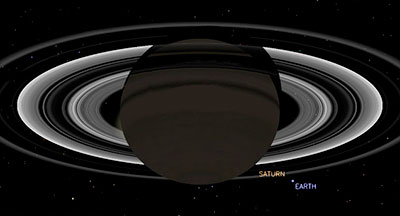 Above: This simulated view from NASA's Cassini spacecraft shows the expected positions of Saturn and Earth on July 19, 2013, around the time Cassini will take Earth's picture. Cassini will be about 898 million miles (1.44 billion kilometers) away from Earth at the time. That distance is nearly 10 times the distance from the sun to Earth. (Image credit: NASA/JPL-Caltech) Earth will appear as a small, pale blue dot between the rings of Saturn in the image, which will be part of a mosaic, or multi-image portrait, of the Saturn system Cassini is composing. "While Earth will be only about a pixel in size from Cassini's vantage point 898 million (1.44 billion kilometers) away, the team is looking forward to giving the world a chance to see what their home looks like from Saturn," said Linda Spilker, Cassini project scientist at NASA's Jet Propulsion Laboratory (JPL) in Pasadena, Calif. "We hope you'll join us in waving at Saturn from Earth, so we can commemorate this special opportunity." Cassini will start obtaining the Earth part of the mosaic at 5:27 p.m. EDT (2:27 p.m. PDT or 21:27 UTC) and end about 15 minutes later, all while Saturn is eclipsing the sun from Cassini's point of view. The spacecraft's unique vantage point in Saturn's shadow will provide a special scientific opportunity to look at the planet's rings. At the time of the photo, North America and part of the Atlantic Ocean will be in sunlight. Unlike two previous Cassini eclipse mosaics of the Saturn system in 2006, which captured Earth, and another in 2012, the July 19 image will be the first to capture the Saturn system with Earth in natural color, as human eyes would see it. It also will be the first to capture Earth and its moon with Cassini's highest-resolution camera. The probe's position will allow it to turn its cameras in the direction of the sun, where Earth will be, without damaging the spacecraft's sensitive detectors. "Ever since we caught sight of the Earth among the rings of Saturn in September 2006 in a mosaic that has become one of Cassini's most beloved images, I have wanted to do it all over again, only better," said Carolyn Porco, Cassini imaging team lead at the Space Science Institute in Boulder, Colo. "This time, I wanted to turn the entire event into an opportunity for everyone around the globe to savor the uniqueness of our planet and the preciousness of the life on it." Porco and her imaging team associates examined Cassini's planned flight path for the remainder of its Saturn mission in search of a time when Earth would not be obstructed by Saturn or its rings. Working with other Cassini team members, they found the July 19 opportunity would permit the spacecraft to spend time in Saturn's shadow to duplicate the views from earlier in the mission to collect both visible and infrared imagery of the planet and its ring system. "Looking back towards the sun through the rings highlights the tiniest of ring particles, whose width is comparable to the thickness of hair and which are difficult to see from ground-based telescopes," said Matt Hedman, a Cassini science team member based at Cornell University in Ithaca, N.Y., and a member of the rings working group. "We're particularly interested in seeing the structures within Saturn's dusty E ring, which is sculpted by the activity of the geysers on the moon Enceladus, Saturn's magnetic field and even solar radiation pressure." This latest image will continue a NASA legacy of space-based images of our fragile home, including the 1968 "Earthrise" image taken by the Apollo 8 moon mission from about 240,000 miles (380,000 kilometers) away and the 1990 "Pale Blue Dot" image taken by Voyager 1 from about 4 billion miles (6 billion kilometers) away. |
cspg
Member Posts: 6215
From: Geneva, Switzerland
Registered: May 2006
|
 posted 06-18-2013 03:34 PM
posted 06-18-2013 03:34 PM
   
Fragile and also how insignificant. For scale comparisons, look at the Astronomy Picture of the Day (APOD) for June 6. |
Robert Pearlman
Editor Posts: 43249
From: Houston, TX
Registered: Nov 1999
|
 posted 07-21-2013 08:43 AM
posted 07-21-2013 08:43 AM
   
The full image is still to be released but here is a preview — the blueish pixel below Saturn's rings is Earth...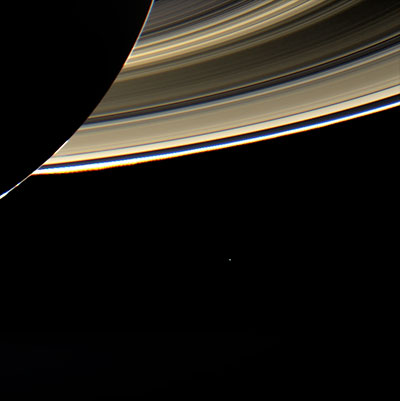 |
Robert Pearlman
Editor Posts: 43249
From: Houston, TX
Registered: Nov 1999
|
 posted 07-21-2013 09:07 AM
posted 07-21-2013 09:07 AM
   
And here is the raw image of the Earth-Moon system (some of the specks in the background are stars, while other are noise from the Cassini's image sensor):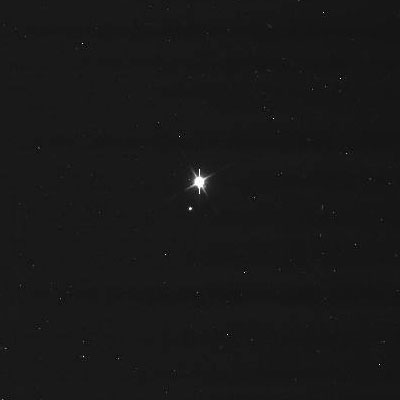 |
gliderpilotuk
Member Posts: 3400
From: London, UK
Registered: Feb 2002
|
 posted 07-22-2013 04:49 AM
posted 07-22-2013 04:49 AM
   
Just "WOW"!  The shot with the rings really puts life into perspective. |
Tykeanaut
Member Posts: 2215
From: Worcestershire, England, UK.
Registered: Apr 2008
|
 posted 07-22-2013 05:38 AM
posted 07-22-2013 05:38 AM
   
Gosh, we're fragile aren't we? |
cspg
Member Posts: 6215
From: Geneva, Switzerland
Registered: May 2006
|
 posted 07-23-2013 05:39 AM
posted 07-23-2013 05:39 AM
   
quote:
Originally posted by Robert Pearlman:
And here is the raw image of the Earth-Moon system (some of the specks in the background are stars, while other are noise from the Cassini's image sensor)
I find this image confusing. There's a telescope aboard Cassini? For what purpose?You can't see Saturn's rings from Earth without a telescope so I'm having a hard time believing that, even with image enhancement, you could see the Earth-Moon duo from Saturn. As a case in point, look at Astronomy Picture of the Day (APOD) for July 23 (comparison of view of Earth from Saturn (900 million miles) and Messenger probe (61 million miles). Am I missing something? |
Robert Pearlman
Editor Posts: 43249
From: Houston, TX
Registered: Nov 1999
|
 posted 07-23-2013 07:39 AM
posted 07-23-2013 07:39 AM
   
Yes, Cassini is outfitted with a telescope, of sorts, its narrow-angle camera: Narrow Angle works much like a telephoto lens, which is good for close up images. In particular, it is a reflecting telescope with a focal length of 2000 mm and a field of view of 0.35 degrees. Of course, in this case, the narrow-angle camera wasn't used for a close-up of Saturn, its rings or moons, but of a very distant target — the Earth. The highest resolution camera (narrow-angle camera or NAC) on Cassini's imaging science subsystem is an array of 1,024 by 1,024 pixels (a 1 mega-pixel camera!) with an angular field of view of 6.134 milli-radians. This means that each pixel has an angular view of 5.9907 micro-radians of the sky. The Earth, with a diameter of 7,926 miles (12,756 kilometers), is at a distance of 898,500 million miles (1.446 billion kilometers) from Cassini at this time. Dividing the size of the earth by the Earth-Cassini distance, this translates to an angle of about 8.83 micro-radians. Ideally, this means that the Earth will be roughly 1.47 pixels across in the image. Due to the optical properties of the NAC telescope, the Earth will span a bit more than this value. We call this factor the point spread function and it is equal to 1.3 for the NAC. The end result is that the Earth's photogenic image will span approximately 1.9 pixels across (thus a 2 by 2 image). However, since not all of Earth is illuminated at this time — less than half — the pale blue shine that we'll see of Earth will be less than a pixel. |
cspg
Member Posts: 6215
From: Geneva, Switzerland
Registered: May 2006
|
 posted 07-23-2013 10:18 AM
posted 07-23-2013 10:18 AM
   
Ok. Thanks for clearing up this for me. |
Blackarrow
Member Posts: 3134
From: Belfast, United Kingdom
Registered: Feb 2002
|
 posted 07-23-2013 05:46 PM
posted 07-23-2013 05:46 PM
  
By way of comparison, Voyager 1 imaged the Earth (Carl Sagan's "pale blue dot") from 3.7 BILLION miles away (more than four times the Earth-Saturn distance) in 1990. |
mach3valkyrie
Member Posts: 719
From: Albany, Oregon
Registered: Jul 2006
|
 posted 07-23-2013 07:28 PM
posted 07-23-2013 07:28 PM
   
Images like this really put things in perspective. Check out NASA's Astronomy Picture of the Day Archives for a view from the Messenger spacecraft at Mercury of the Earth-Moon system from 61 million miles away. |
lspooz
Member Posts: 385
From: Greensboro, NC USA
Registered: Aug 2012
|
 posted 08-06-2013 12:28 PM
posted 08-06-2013 12:28 PM
   
quote:
Originally posted by cspg:
You can't see Saturn's rings from Earth without a telescope so I'm having a hard time believing that, even with image enhancement, you could see the Earth-Moon duo from Saturn.
As a quick-n-dirty estimate: since Saturn is ~9 AU away from us it gets hit with 1/81-st of the sunlight we do, and then that reflected sunlight is 1/81-st as dim when it gets back here. From Cassini's point of view we're ~ 6500x times brighter than Saturn is to us... |
canyon42
Member Posts: 238
From: Ohio
Registered: Mar 2006
|
 posted 08-06-2013 04:33 PM
posted 08-06-2013 04:33 PM
   
The first part of that estimate may work, but I think the second part gets canceled out by the fact that Earth is just as far away from Saturn (and Cassini) as the other way around. Plus, it doesn't take into account that Saturn is much larger (hence more surface area to reflect) than the Earth, not to mention the added reflected light courtesy of the rings.Would be interesting to know the actual brightness of Earth as seen from Saturn. In general, Saturn is 1st magnitude from here. |
lspooz
Member Posts: 385
From: Greensboro, NC USA
Registered: Aug 2012
|
 posted 08-06-2013 05:28 PM
posted 08-06-2013 05:28 PM
   
quote:
Originally posted by canyon42:
The first part of that estimate may work, but I think the second part gets canceled out by the fact that Earth is just as far away from Saturn (and Cassini) as the other way around.
No, since our view of Saturn is based on light from Sun to Saturn then BACK to Earth, while Cassini's view is Eath-->Saturn.
Granted, Saturn's size and slightly higher albedo may reflect perhaps 10x more light, but my estimate is rough.Actual 'magnitude' of the Earth should be measurable based on Cassini's sensors. |
canyon42
Member Posts: 238
From: Ohio
Registered: Mar 2006
|
 posted 08-06-2013 07:13 PM
posted 08-06-2013 07:13 PM
   
quote:
Originally posted by lspooz:
No, since our view of Saturn is based on light from Sun to Saturn then BACK to Earth, while Cassini's view is Eath-->Saturn.
Don't think this follows. Just as our view of Saturn is indeed based on a light path from Sun to Saturn and back to Earth, a view of Earth from Saturn is based on a light path from Sun to Earth (which is indeed more "intense" because of Earth's closer proximity to the Sun) and then from the Earth to Saturn--which is the same distance as that from Saturn to Earth. The diminishing of light intensity in that part of the light's journey is identical no matter which way it's going. There would certainly be a brightening factor due to Earth's closer status to the Sun, but not in the second part of the path.If Earth and Saturn were the same size and albedo, that would be it for the calculation--Saturn would appear about 1/81 as bright as seen from here compared to how we look from Saturn. But as noted, Saturn is much larger than the Earth--about 9 times greater in diameter, which gives it about 65 times greater surface area. And then you have to figure in the rings (except when they are edge-on), which add substantially to Saturn's apparent brightness. I found an estimate online that Earth should have appeared at about magnitude 1.3 from Saturn at the time of the photo, or just a bit dimmer than Saturn usually appears to us. Unfortunately that estimate was not supported by anything, so I'll keep looking. |
Ross
Member Posts: 473
From: Australia
Registered: Jul 2003
|
 posted 08-07-2013 09:46 AM
posted 08-07-2013 09:46 AM
   
quote:
Originally posted by lspooz:
No, since our view of Saturn is based on light from Sun to Saturn then BACK to Earth, while Cassini's view is Earth-->Saturn.
I believe this quote is basically correct. One caveat is that it will depend on the position of the Earth and Saturn in their orbits. For example, they may be on approximately opposite sides of the sun. However, let's take the simplest case. The Earth is between the Sun and Saturn in a direct line. Take a light ray from the Sun. It will first reach the Earth and then go on to Saturn, at which point Cassini could see the Earth. But for someone on the Earth to see Saturn, the light ray must then be reflected off Saturn and travel back to the Earth, for a total distance of a little under twice the distance from the Sun to Saturn. If all else was the same Saturn would be a little under 1/81 the brightness of the Earth from Saturn. Now Saturn's radius is 9.49 times that of Earth and the ratio of the area of two circles is radius squared. That gives approx. 90 times the area (yes I know that is very approximate) which gives 90/81 or 1.1. Now the albedo ratio is approx. 1.28 which gives 1.1 X 1.28 equals 1.4. Since all these figures are very approximate and I've ignored a few modifying factors the 1.3 mentioned seems quite reasonable. |
canyon42
Member Posts: 238
From: Ohio
Registered: Mar 2006
|
 posted 08-07-2013 02:20 PM
posted 08-07-2013 02:20 PM
   
Incidentally, while searching on the web I came across this page, which gives simulated views of various bodies in the solar system from other spots in the system (including numerous space probes) at whatever date and time the user wishes to input. It unfortunately does not include visual magnitudes (which is what we were looking for in the first place!), but it is still very, very cool.  |
Robert Pearlman
Editor Posts: 43249
From: Houston, TX
Registered: Nov 1999
|
 posted 11-12-2013 10:07 AM
posted 11-12-2013 10:07 AM
   
NASA photo release The Faces of 'Wave at Saturn'This collage includes about 1,600 images submitted by members of the public as part of the NASA Cassini mission's "Wave at Saturn" campaign. 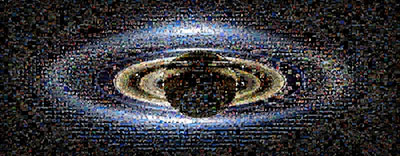 On July 19, 2013, Cassini maneuvered into a special location to take a picture of the Saturn system backlit by the sun. Blocking out the sun's rays also enabled Cassini to take a picture of Earth, which would normally require looking almost directly at the sun and risking damage to the cameras' sensitive detectors. The "Wave at Saturn" event was the first to tell earthlings in advance that their picture was being taken from interplanetary distances. Earth Waves at Cassini From more than 40 countries and 30 U.S. states, people around the world shared more than 1,400 images of themselves as part of the Wave at Saturn event organized by NASA's Cassini mission. The images came via Twitter, Facebook, Flickr, Instagram, Google+ and email. As a tribute to the people of Earth, the mission has assembled this collage from the shared images, using an image of Earth as the base image. 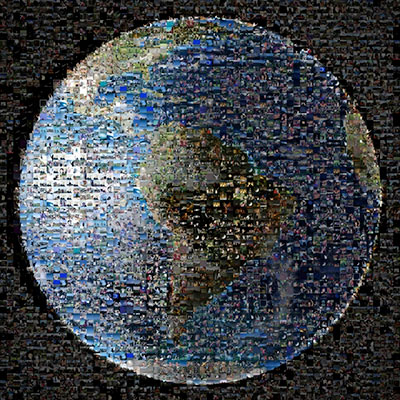 |
Robert Pearlman
Editor Posts: 43249
From: Houston, TX
Registered: Nov 1999
|
 posted 11-12-2013 10:12 AM
posted 11-12-2013 10:12 AM
   
NASA photo release The Day the Earth SmiledOn July 19, 2013, in an event celebrated the world over, NASA's Cassini spacecraft slipped into Saturn's shadow and turned to image the planet, seven of its moons, its inner rings — and, in the background, our home planet, Earth. With the sun's powerful and potentially damaging rays eclipsed by Saturn itself, Cassini's onboard cameras were able to take advantage of this unique viewing geometry. They acquired a panoramic mosaic of the Saturn system that allows scientists to see details in the rings and throughout the system as they are backlit by the sun. 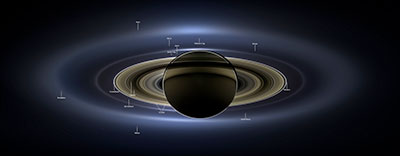 This mosaic is special as it marks the third time our home planet was imaged from the outer solar system; the second time it was imaged by Cassini from Saturn's orbit; and the first time ever that inhabitants of Earth were made aware in advance that their photo would be taken from such a great distance. With both Cassini's wide-angle and narrow-angle cameras aimed at Saturn, Cassini was able to capture 323 images in just over four hours. This final mosaic uses 141 of those wide-angle images. Images taken using the red, green and blue spectral filters of the wide-angle camera were combined and mosaicked together to create this natural-color view. A brightened version with contrast and color enhanced, a version with just the planets annotated, and an unannotated version are also available. This image spans about 404,880 miles (651,591 kilometers) across. The outermost ring shown here is Saturn's E ring, the core of which is situated about 149,000 miles (240,000 kilometers) from Saturn. The geysers erupting from the south polar terrain of the moon Enceladus supply the fine icy particles that comprise the E ring; diffraction by sunlight gives the ring its blue color. Enceladus (313 miles, or 504 kilometers, across) and the extended plume formed by its jets are visible, embedded in the E ring on the left side of the mosaic. At the 12 o'clock position and a bit inward from the E ring lies the barely discernible ring created by the tiny, Cassini-discovered moon, Pallene (3 miles, or 4 kilometers, across). (For more on structures like Pallene's ring, see PIA08328). The next narrow and easily seen ring inward is the G ring. Interior to the G ring, near the 11 o'clock position, one can barely see the more diffuse ring created by the co-orbital moons, Janus (111 miles, or 179 kilometers, across) and Epimetheus (70 miles, or 113 kilometers, across). Farther inward, we see the very bright F ring closely encircling the main rings of Saturn. Following the outermost E ring counter-clockwise from Enceladus, the moon Tethys (662 miles, or 1,066 kilometers, across) appears as a large yellow orb just outside of the E ring. Tethys is positioned on the illuminated side of Saturn; its icy surface is shining brightly from yellow sunlight reflected by Saturn. Continuing to about the 2 o'clock position is a dark pixel just outside of the G ring; this dark pixel is Saturn's Death Star moon, Mimas (246 miles, or 396 kilometers, across). Mimas appears, upon close inspection, as a very thin crescent because Cassini is looking mostly at its non-illuminated face. The moons Prometheus, Pandora, Janus and Epimetheus are also visible in the mosaic near Saturn's bright narrow F ring. Prometheus (53 miles, or 86 kilometers, across) is visible as a faint black dot just inside the F ring and at the 9 o'clock position. On the opposite side of the rings, just outside the F ring, Pandora (50 miles, or 81 kilometers, across) can be seen as a bright white dot. Pandora and Prometheus are shepherd moons and gravitational interactions between the ring and the moons keep the F ring narrowly confined. At the 11 o'clock position in between the F ring and the G ring, Janus (111 miles, or 179 kilometers, across) appears as a faint black dot. Janus and Prometheus are dark for the same reason Mimas is mostly dark: we are looking at their non-illuminated sides in this mosaic. Midway between the F ring and the G ring, at about the 8 o'clock position, is a single bright pixel, Epimetheus. Looking more closely at Enceladus, Mimas and Tethys, especially in the brightened version of the mosaic, one can see these moons casting shadows through the E ring like a telephone pole might cast a shadow through a fog. In the non-brightened version of the mosaic, one can see bright clumps of ring material orbiting within the Encke gap near the outer edge of the main rings and immediately to the lower left of the globe of Saturn. Also, in the dark B ring within the main rings, at the 9 o'clock position, one can see the faint outlines of two spoke features, first sighted by NASA's Voyager spacecraft in the early 1980s and extensively studied by Cassini. Finally, in the lower right of the mosaic, in between the bright blue E ring and the faint but defined G ring, is the pale blue dot of our planet, Earth. Look closely and you can see the moon protruding from the Earth's lower right. Earth's twin, Venus, appears as a bright white dot in the upper left quadrant of the mosaic, also between the G and E rings. Mars also appears as a faint red dot embedded in the outer edge of the E ring, above and to the left of Venus. For ease of visibility, Earth, Venus, Mars, Enceladus, Epimetheus and Pandora were all brightened by a factor of eight and a half relative to Saturn. Tethys was brightened by a factor of four. In total, 809 background stars are visible and were brightened by a factor ranging from six, for the brightest stars, to 16, for the faintest. The faint outer rings (from the G ring to the E ring) were also brightened relative to the already bright main rings by factors ranging from two to eight, with the lower-phase-angle (and therefore fainter) regions of these rings brightened the most. The brightened version of the mosaic was further brightened and contrast-enhanced all over to accommodate print applications and a wide range of computer-screen viewing conditions. Some ring features — such as full rings traced out by tiny moons — do not appear in this version of the mosaic because they require extreme computer enhancement, which would adversely affect the rest of the mosaic. This version was processed for balance and beauty. This view looks toward the unlit side of the rings from about 17 degrees below the ring plane. Cassini was approximately 746,000 miles (1.2 million kilometers) from Saturn when the images in this mosaic were taken. Image scale on Saturn is about 45 miles (72 kilometers) per pixel. This mosaic was made from pictures taken over a span of more than four hours while the planets, moons and stars were all moving relative to Cassini. Thus, due to spacecraft motion, these objects in the locations shown here were not in these specific places over the entire duration of the imaging campaign. Note also that Venus appears far from Earth, as does Mars, because they were on the opposite side of the sun from Earth. | |
Contact Us | The Source for Space History & Artifacts
Copyright 2020 collectSPACE.com All rights reserved.

Ultimate Bulletin Board 5.47a
|
|

|
 advertisement advertisement

|



















